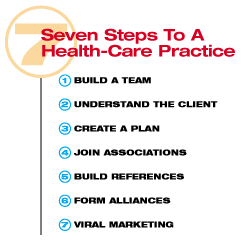How To Succeed In Health Care
Word-of-mouth referrals and the "viral" spread of technology through the health-care value chains helped it bring in a steady flow of business.
"Keane has the advantage of working across the health-care value chain of providers, payers and government agencies," said Rosemary Abell, director of Keane's health-care practice, a leader in providing IT services to long-term-care facilities with more than 4,000 nursing homes, hospitals and other care providers among its clients.
She said Keane also benefits from a deep bench of industry experts and industry-specific methodologies built up over time. "Clients want our industry expertise," Abell said.
Building such a health-care practice requires time, commitment and investment. But once established, it can pay off. With experts anticipating steady growth in health-care IT spending, solution providers without Keane's long history in that market still have plenty of opportunity to build successful practices by leveraging expertise in areas such as networking, security, storage and mobile solutions.
The opportunities are huge. Research firm Gartner estimates that health-care IT annual spending will exceed $35 billion this year, driven by government regulation, a desire to improve patient care and intense competition among hospitals. Health-care organizations are investing in new levels of application integration, secure networks, imaging and storage systems and mobile technologies.
The process that Keane and other integrators have followed in building a successful health-care practice generally boils down to seven basic steps, gleaned from interviews with large and regional solution providers in the market.
For solution providers that have a health-care practice, achieving excellence in these steps can lead to revenue and profit growth. For regional solution providers that may have a few health-care customers but not a full-fledged practice, these steps can help systematically expand business in the sector.
The first step to forming any practice is building the right team,or as Abell put it, "Get the right people on the right bus."
Large solution providers will establish an executive to lead a team dedicated to health care. Smaller solution providers often establish a five-person task force with a leader, executive sponsor and representatives from professional services, sales and marketing.
The next step: Understand the client and its constituents.

Providing quality patient care is at the heart of Centre Community Hospital's IT decision-making, said Pam Lautsch, assistant director of technical services at the State College, Pa.-based hospital. "To succeed in health care, start with the perspective of a patient," she advised.
"As a patient, you want your physicians and nurses to have your complete medical information at their fingertips," Lautsch said. "You want your privacy securely protected. You do not want to have your emergency treatment delayed while servers reboot."
For hospitals, another important constituency is physicians, who often can choose from several competing hospitals when referring patients.
"The No. 1 concern for the administrators of most hospitals is the loyalty of the physicians," said David Moore, CIO of Spectrum Laboratory Network, the laboratory services division of Premier Health Systems of Columbia, S.C.
He said hospitals will welcome any idea that helps secure the loyalty of physicians, who have high expectations about accessing information. Spectrum, whose laboratory services several hospitals and hundreds of physicians, turned to Atlas Development, a developer and integrator in Woodland Hills, Calif., to automate its 5,000 daily work orders.
"One hospital can provide better service than another hospital by automating the flow of information from physicians and their back-office systems through laboratory testing to presenting the results," Moore said.
Similarly, Centre Community Hospital has deployed an integrated health information system from Westwood, Mass.-based Meditech that handles patient care, financials, laboratory information, medical records and decision support.
A major initiative is the implementation of an Enterprise Medical Records System, which provides a single source for viewing all relevant patient information and often drives major storage and network infrastructure sales.
Centre Community Hospital, like thousands of hospitals, rewards technology providers that have taken the time to understand health care. The hospital brought in PC Solutions, a Pittsburgh-based solution provider, to conduct a network study and implement a Windows 2000 migration recommendation.
To address federal HIPAA mandates, the hospital engaged System Design Group, an IT professional services firm in Lexington, Ky., to conduct a security assessment and implement security solutions.
The third step, creating a plan, is essential with any new business venture. When Futurelink, an ASP pioneer and Citrix Systems integrator, went bankrupt, Donnie Downs left and took with him 32 other Futurelink employees to create a new business appropriately named Plan B Technologies, Bowie, Md.
The company scraped through 2001 with $1 million in revenue, which jumped to $6.5 million last year after Downs formalized a security and storage practice. Health care emerged as an important vertical market for both practices.
"Have one person lead a practice," Downs advised. "Conduct exhaustive up-front planning on your needed technology. Take time to explore all business and technical issues with vendors."
In creating a plan, solution providers should be clear about their long-term health-care goals, analyze the market and potential customers, start with their technology strengths, and reach team agreement on the criteria for ideal technology, vendors and alliances. The plan should also include 12-month milestones that specifies people and responsibilities, with due dates.
With a plan in hand, the fourth step,particularly vital in the health-care industry,is joining industry associations such as the Healthcare Information and Management Systems Society (HIMSS) and volunteering to work on committees, give speeches and sponsor events, solution providers in the market said.
DigitalCare, a 1997 startup in Colorado Springs, Colo., got a big break when it was hired by the state of New Mexico to conduct HIPAA seminars throughout that state. That project led to engagements with various hospitals, which hired the health-care integrator to help them comply with the federal mandates.

Daou Systems, a health-care solution provider in San Diego, conducts regional forums for health-care CIOs on such topics as government regulations, application integration and mobile health-care solutions. John Smaling, vice president of the company, said the forums are a great marketing tool for Daou.
Building reference accounts is step five. A health-care practice begins with one customer, and ensuring that customer is delighted can pay big dividends.
Plan B was able to leverage its Citrix expertise to land a job helping Johns Hopkins Hospital, Baltimore, with one security issue. While the task was small, the outcome was that the integrator's work led to engagements with other areas of the Johns Hopkins health system, medical research and university organizations, Downs said.
The engagements included enterprise Windows consulting and server and SAN implementations. Medical imaging and information systems can demand terabytes of storage, creating large opportunities for storage integrators that can get their foot in the door. A single reference account can be crucial.
Because many hospitals are owned by universities and governments, reference accounts in government or education sectors can also often gain a solution provider access to the health-care sector.
Step six is forming alliances. Health care is a natural area for forming alliances between experts in security, storage, applications and clinical solutions.
Advanced Internet Security, Colorado Springs, got its start in health care by installing a firewall at a hospital and then formed a close alliance with DigitalCare, the outfit conducting HIPAA seminars in New Mexico, to meet client needs in administrative areas.
"Partner with someone strong in the industry [and] make sure that your skills are complementary, not competitive," said Gary Cannon, president of the security services firm.
Cannon said up-front planning is crucial to successful alliances, and he advised partners to clarify roles and responsibilities and create joint marketing materials in the process.
The final step is a marketing plan. Health care is perfect for viral marketing. Do good work for one physician, and you will be referred to other physicians, then to the physicians' hospitals, then to their clinical lab providers, then to government agencies, solution providers said.
Atlas Development, in addition to automating work orders for medical labs, also has a solution that enables labs to automatically report communicable disease and bioterrorism information to government agencies. That solution is bringing Atlas Development business from health-care providers that report to these agencies.
For many solution integrators, a health-care practice starts with a single medical office asking for help in one area of security, storage or applications. With referrals, alliances and marketing, solution integrators expand across the value chain of providers, payers, government agencies and pharmaceutical concerns. Put these seven steps into action and watch your revenue skyrocket.
John Addison ([email protected]) is president of Optimark Inc., a strategic consulting firm for channel companies. He is the author of the book "Revenue Rocket."